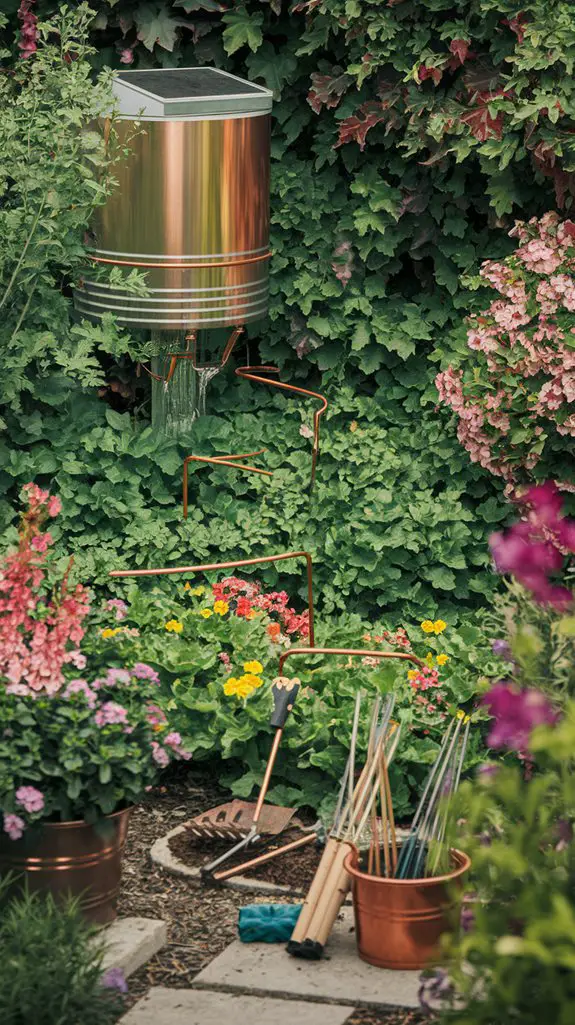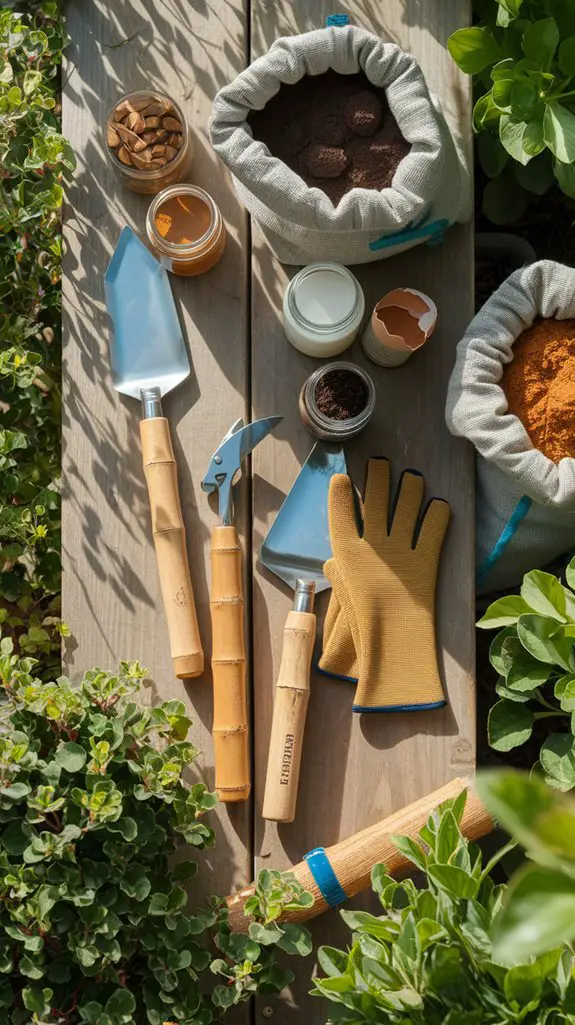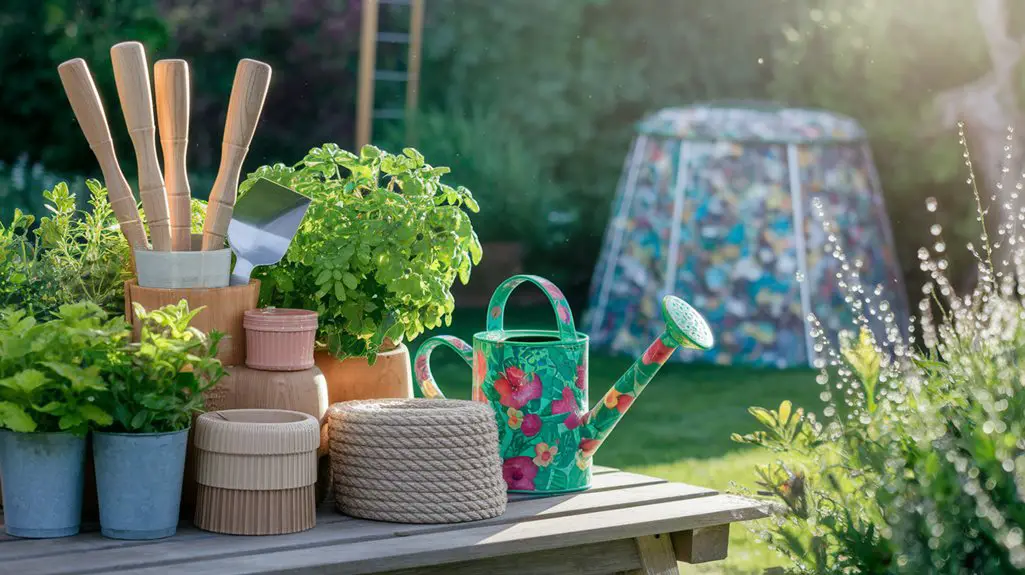Isn’t it remarkable how the simplest gardening choices can ripple through our entire ecosystem? You’re making critical environmental decisions each time you select a gardening tool or supply. By switching to sustainable materials, water-conserving systems, and organic amendments, you’ll reduce your carbon footprint while creating a thriving garden sanctuary. Your plants will respond with vigorous growth, beneficial insects will return, and you’ll save money—all while helping preserve our planet for future generations.
Essential Hand Tools Made From Sustainable Materials
Gardeners of the eco-conscious era now have unprecedented access to hand tools crafted from sustainable materials.
These implements typically feature handles made from FSC-certified hardwoods, bamboo, or recycled composites that replace petroleum-based plastics. Look for trowels, pruners, and cultivators with metal components forged from recycled stainless steel—offering durability while reducing virgin material extraction.
Particularly innovative are tools incorporating bioplastics derived from cornstarch or sugarcane, which decompose naturally at their end-of-life.
When selecting hand tools, prioritize those with replaceable parts to extend usability. Companies like EarthSmith and Terra Tools now offer carbon-negative manufacturing processes, sequestering more carbon than they emit.
Remember that sustainable tools often require specific maintenance—apply natural linseed oil to wooden handles and store them properly to maximize their operational lifespan.
Eco-Friendly Watering Systems and Conservation Techniques

Water conservation represents the next frontier in sustainable gardening practices after tool selection.
Implement drip irrigation systems that deliver water directly to plant roots, reducing evaporation by up to 60% compared to sprinklers. Consider installing rain barrels beneath downspouts to capture runoff—a 55-gallon barrel can fill completely during just 0.25 inches of rainfall on a 1,000-square-foot roof. Additionally, harnessing rainwater not only conserves water but also promotes a more sustainable gardening ecosystem.
For container gardens, try self-watering planters with built-in reservoirs that use capillary action to provide consistent moisture. Terra cotta watering spikes paired with recycled glass bottles create simple, targeted irrigation that minimizes waste. Supplement these systems with moisture meters to prevent overwatering, and apply organic mulch 2-3 inches deep around plants to retain soil moisture.
These integrated approaches can reduce your garden’s water consumption by 70% while maintaining peak plant health.
Organic Fertilizers and Natural Soil Amendments

While chemical fertilizers provide quick nutrient boosts, organic alternatives offer superior long-term soil health benefits without environmental contamination risks.
You’ll find multiple natural options to enhance your soil’s fertility: compost derived from kitchen scraps and yard waste, well-aged manure from herbivores, bone meal for phosphorus, and seaweed extracts rich in micronutrients.
Consider applying worm castings, nature’s perfect soil amendment containing beneficial microbes that improve soil structure.
Wood ash provides potassium for flowering plants, while crushed eggshells deliver calcium that prevents blossom-end rot in tomatoes.
For acidic soil-loving plants like blueberries, incorporate pine needles or coffee grounds.
Remember that organic amendments work gradually, building soil health over time rather than forcing rapid growth that weakens plants’ natural resilience. Additionally, integrating effective natural solutions can significantly reduce pest issues without harming beneficial insects.
Biodegradable Pots, Planters, and Growing Containers
The shift toward biodegradable growing containers represents a significant advancement in sustainable gardening practices. These eco-conscious alternatives to plastic pots break down naturally after use, reducing landfill waste and microplastic pollution.
You’ll find several options including coconut coir pots, compressed peat containers, and molded rice hull planters. Each decomposes at different rates, with coir lasting 1-2 years while peat biodegrades within months.
Many seedling pots can be planted directly into soil, eliminating transplant shock while adding organic matter.
For longer-term container gardening, look for planters made from bamboo, recycled paper, or mushroom mycelium. These materials provide structural integrity during use but return to the ecosystem afterward.
When selecting biodegradable containers, consider your climate conditions and watering needs, as some materials break down faster in humid environments.
Solar-Powered Garden Equipment and Lighting
Harnessing the sun’s abundant energy, solar-powered garden tools and lighting systems offer sustainable alternatives to their fossil fuel or grid-dependent counterparts.
These innovations reduce your carbon footprint while providing reliable performance for everyday gardening tasks.
Modern solar technology has evolved to power everything from lawn mowers to water pumps, eliminating emissions and reducing noise pollution.
You’ll find these tools particularly valuable in remote garden areas where electrical outlets aren’t accessible.
- Solar-powered LED path lights consume 75% less energy than traditional options while lasting up to 25 times longer
- Solar water pumps for fountains and irrigation systems operate autonomously, adjusting to available sunlight
- Motion-activated solar security lights provide dual benefits of garden safety and energy conservation
Additionally, incorporating eco-friendly materials into your garden water feature can enhance sustainability and aesthetics.
Compost Bins and Worm Farms for Organic Waste Recycling
Natural plant and food waste represents one of your garden’s most valuable untapped resources, transforming through composting systems into nutrient-rich soil amendments that complete nature’s recycling loop.
Select from tumbling bins that accelerate decomposition through aeration, stationary three-bin systems that allow continuous production, or in-ground digesters for discreet processing.
For apartment dwellers or those with limited space, bokashi fermentation systems enable kitchen waste processing without odors.
Worm farms offer another efficient approach, with red wigglers converting scraps into vermicompost—a microbially active amendment that enhances soil structure and plant immunity.
When choosing a system, consider your space constraints, waste volume, and desired processing speed.
The most effective setups balance carbon-rich “browns” with nitrogen-dense “greens” to optimize decomposition. Additionally, incorporating natural pest control practices can further enhance your garden’s health and sustainability.
Non-Toxic Pest Control Solutions and Wildlife-Friendly Barriers
While nurturing your garden through organic waste recycling creates healthy soil, protecting plants from pests requires equally thoughtful eco-conscious approaches.
Consider investing in diatomaceous earth, neem oil sprayers, or copper tape barriers—all natural alternatives to chemical pesticides. These solutions deter unwanted visitors without harming beneficial insects or contaminating soil and waterways.
Wildlife-friendly barriers like bamboo fencing, recycled plastic mesh, or biodegradable netting protect your garden while minimizing environmental impact.
These materials create boundaries that:
- Allow beneficial organisms to move freely while blocking larger pests
- Weather naturally without releasing microplastics into soil
- Provide wind protection without disrupting local ecosystem services
For severe infestations, try solar-powered ultrasonic repellers or predator urine granules—both effective deterrents that leave no toxic residue in your garden ecosystem. Additionally, incorporating organic pest control methods helps to maintain a balanced garden environment, further enhancing plant health and resilience.
Conclusion
By embracing these sustainable gardening tools and practices, you’ll transform your garden into a living laboratory of environmental stewardship. Like a ripple in a pond, your eco-conscious choices extend far beyond your garden’s boundaries—conserving precious resources, reducing chemical runoff, and creating wildlife habitats. Remember, it’s not just about what you grow, but how you grow it that determines your true environmental footprint.




